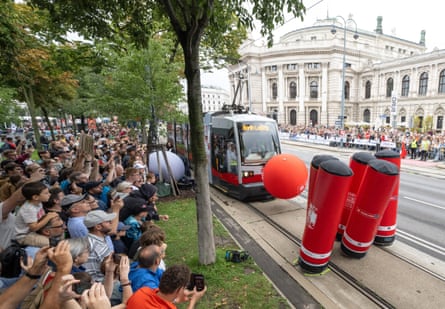Tram driver Sally Burgess has never deliberately collided with another object on the track – until last weekend, that is, when she hit a giant ball as hard as she could with the bumper of her tram. The goal: to knock down a series of 2-metre-tall rubber pins, like oversized skittles, lined up on the track ahead.
“I said I would smash the ball and I smashed the ball,” Burgess tells Guardian Australia. “Only one pin came down, though. It’s pretty hard to get all those pins down.”
Far from an ill-advised jape, this giant game of tram bowling was a serious competitive bout. Burgess was in Vienna, Austria, with her colleague Craig Maher, representing Melbourne, Australia, in the world tram driver championship.
The tournament has traditionally been a European affair, but Australia became the first non-European country to compete – on account of Melbourne’s extensive tram network – in Leipzig, Germany, in 2022. This year, though, the games went truly global, with tram-driving duos from 25 cities around the world gathering in the Austrian capital on 13 September to show off their skills. A 250-metre-long section of track was cordoned off in the city centre to host the championship, and more than 15,000 spectators attended over the course of the day, with many more watching it via livestream.

The games involved each team completing eight challenges twice over, with the drivers alternating roles each time, and points awarded for precision and timing. Along with tram bowling, the challenges included tram curling (using the tram to push a trolley along the track to a target point), speed and target braking (accelerating to 25km/h without the use of a speedometer, then stopping at a specific point) and reversing with the aid of a whistle.
In the stop-and-go challenge, a container of water was balanced on a platform at the front of the tram, and points were awarded according to how little water was spilt after three designated stops. In the lateral distance challenge, the team placed an obstacle at the side of the track. Points were awarded for how close the tram came to the object as it passed, but no points were awarded for a collision.
Sign up: AU Breaking News email
“It felt like we were doing a driving test in front of tens of thousands of other people,” says Burgess. “It’s really quite intense.”
Like many sports, competitive tram driving can be significantly affected by weather conditions – rain, for example, alters a tram’s braking and acceleration – but the biggest advantage in this game is familiarity with the vehicle itself.
Burgess and Maher were first-time competitors, up against returning teams. They trained on Melbourne’s E-class trams for about four weeks before heading over to Vienna, but were only able to spend a short amount of time on the day before the competition familiarising themselves with the city’s Flexity and ULF trams.
This presented some challenges.
“The buttons were tagged with titles in German,” says Maher. “The control stick that we use to drive the tram was on the left [instead of the right, as they are in E-class trams]. One other thing I noticed was the seat … it’s so much more elevated in Melbourne, whereas the Vienna trams were a lot lower. So visually it was a little bit different.”
The home town team, Vienna, won the championship, with Poznan coming second and Oslo third. Burgess and Maher landed much further down the rankings, but they haven’t let that dampen their spirits.
after newsletter promotion

“We were there to represent Australia and give it our best. So on that scale we were absolute winners,” says Maher.
“We went out there with a lot of pride and passion and heart, and the support we have is incredible, and people responded to that,” says Burgess. “Even if we did place 23rd.”
It hasn’t dampened the enthusiasm of their employer, Yarra Trams, either: the day after the games, the Victorian government announced that, following the 2026 event in Poland’s capital, Warsaw, Melbourne will host the championship in 2027.
“This event is more than a competition,” says the Yarra Trams chief executive, Vincent Destot. “It’s a celebration of the people, culture and innovation that make trams such an important part of our city.”
Burgess and Maher speculate about ways they could put an Australian spin on the challenges in two years’ time, suggesting setting up Australian rules football goals instead of bowling pins, and installing a giant flat white at the front of the tram instead of a bowl of water.
Yarra Trams remains tight-lipped as to where on Melbourne’s 250km network of track the 2027 course might be set up, but it will need enough space for a large number of spectators: the public interest in Vienna was so intense, it took the team by surprise.
“When we were driving, doing our challenges, the noise of the crowd that was cheering us on was just incredible, and afterwards, we were kind of mobbed,” says Burgess. “There were hundreds – I mean hundreds – of people cheering and going, ‘Melbourne, Melbourne!’ You felt like a rock star. I’m not going to forget that for the rest of my life.”

 3 months ago
47
3 months ago
47

















































